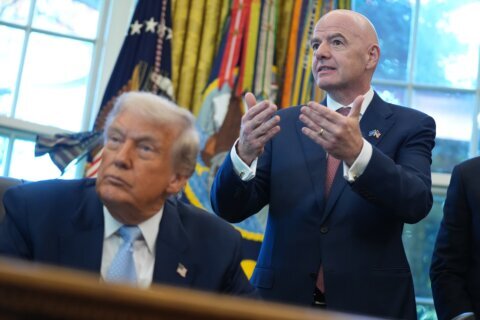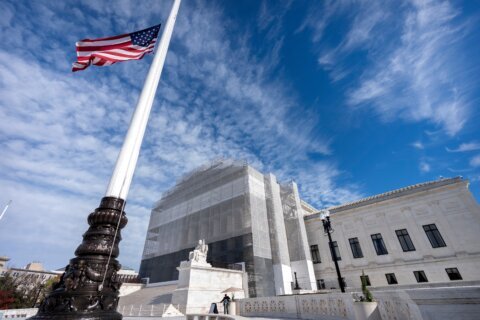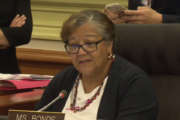NANCY BENAC
Associated Press
WASHINGTON (AP) — Michelle Obama’s fashionable clothing has become something of a given in her five-plus years as first lady. Yet her wardrobe still is the subject of endless public fascination and one long-simmering question: Who pays for those incredible outfits?
It’s no small matter. Her high-low fashion choices mix everyday, off-the-rack fare with custom creations from top designers whose gowns can run into five figures.
In recent weeks, Mrs. Obama has turned heads with a forest-green Naeem Khan dress at the opening of a new costume gallery at New York’s Metropolitan Museum of Art. She shimmered in a silver Marchesa gown at the White House Correspondents’ Association Dinner. And her flowered shirtdress for a Mother’s Day tea at the White House (recycled from an earlier event) hit the just right note for an audience of military moms.
It takes money to pull that off, month after month. Those three dresses by themselves could add up to more than $15,000 retail.
Is it the taxpayers who foot the bill? No. (Despite what critics say.)
Is it Mrs. Obama? Usually, but not always.
Does she pay full price? Not likely.
Does she ever borrow gowns from designers? No.
The financing of the first lady’s wardrobe is a subject that has bedeviled presidents and their wives for centuries.
Mary Todd Lincoln racked up tens of thousands of dollars in clothing bills and considered selling manure from the White House grounds to pay them off, according to the National First Ladies’ Library. Jacqueline Kennedy’s father-in-law stepped in to finance her Oleg Cassini wardrobe to keep clothes from becoming a political liability for President John Kennedy. Nancy Reagan got grief for borrowing designer gowns and not always returning them or reporting them as gifts.
Laura Bush, in her memoir, said she was “amazed by the sheer number of designer clothes that I was expected to buy” as first lady.
How does Mrs. Obama, a fashion icon with far more expensive tastes than Mrs. Bush, swing it?
For starters, the Obamas reported adjusted income of $481,000 last year, and assets worth $1.8 million to $7 million.
And like most people, Mrs. Obama (mostly her personal aide, really) looks for discounts.
And, for really big events, the first lady has an option not available to every fashionista.
Here’s how Joanna Rosholm, press secretary to the first lady, explains it:
“Mrs. Obama pays for her clothing. For official events of public or historic significance, such as a state visit, the first lady’s clothes may be given as a gift by a designer and accepted on behalf of the U.S. government. They are then stored by the National Archives.”
That saves Mrs. Obama considerable money, although the White House refused to say how often the first lady wears donated clothes and the National Archives declined to say how many such items it has in storage. The White House did say that the first lady doesn’t borrow any clothing and, for the most part, buys her own clothes.
The clothing donated by designers includes Mrs. Obama’s two inaugural gowns made by Jason Wu, who declined to discuss how he works with the first lady. Two other examples of gowns worn by the first lady that were donated by designers: the blue Carolina Herrera gown that Mrs. Obama wore to February ‘s state dinner for French President Francois Hollande and the gold-beaded Naeem Khan gown that Mrs. Obama wore to the 2012 governors ball, now on display at the American Museum of Natural History. Herrera and Khan declined comment.
Wearing donated gowns represents a change in practice from the Bush administration.
Anita McBride, chief of staff to Laura Bush during her time as first lady, said Mrs. Bush paid for all her clothes. She credits the Obama White House with finding a cost-saving way to “keep Mrs. Obama in all those incredible clothes and to have the use of them not once but multiple times.”
Lawyers who served in the Obama and Bush White Houses describe taking care in working with the first lady’s office to ensure that arrangements with designers didn’t run afoul of ethics rules designed to guard against conflicts of interest and questionable quid pro quos.
Beyond the unknowns about how often Mrs. Obama’s clothes are donated, there are questions about how much she pays for those she purchases.
Several designers who have provided clothes for the first lady declined to discuss their arrangements. But given the prestige that comes with dressing Mrs. Obama, it’s widely thought that designers are eager to cut the first lady a break. Former White House lawyers said any discounts provided to the first lady would have to be in line with what designers offer other top customers to avoid being considered gifts.
Paco Underhill, author of “What Women Want: The Science of Female Shopping,” said the markups on designer clothes are “astronomical” — and the discounts can be steep as well.
“Some of the routine discounts that people ask for are 40 percent off,” he said.
___
Online:
Smithsonian: http://americanhistory.si.edu/first-ladies/michelle-obama
___
Associated Press writers Brett Zongker in Washington and Beth Harpaz in New York and news researcher Rhonda Shafner in New York contributed to this report.
___
Follow Nancy Benac on Twitter at http://twitter.com/nbenac
Copyright 2014 The Associated Press. All rights reserved. This material may not be published, broadcast, rewritten or redistributed.







